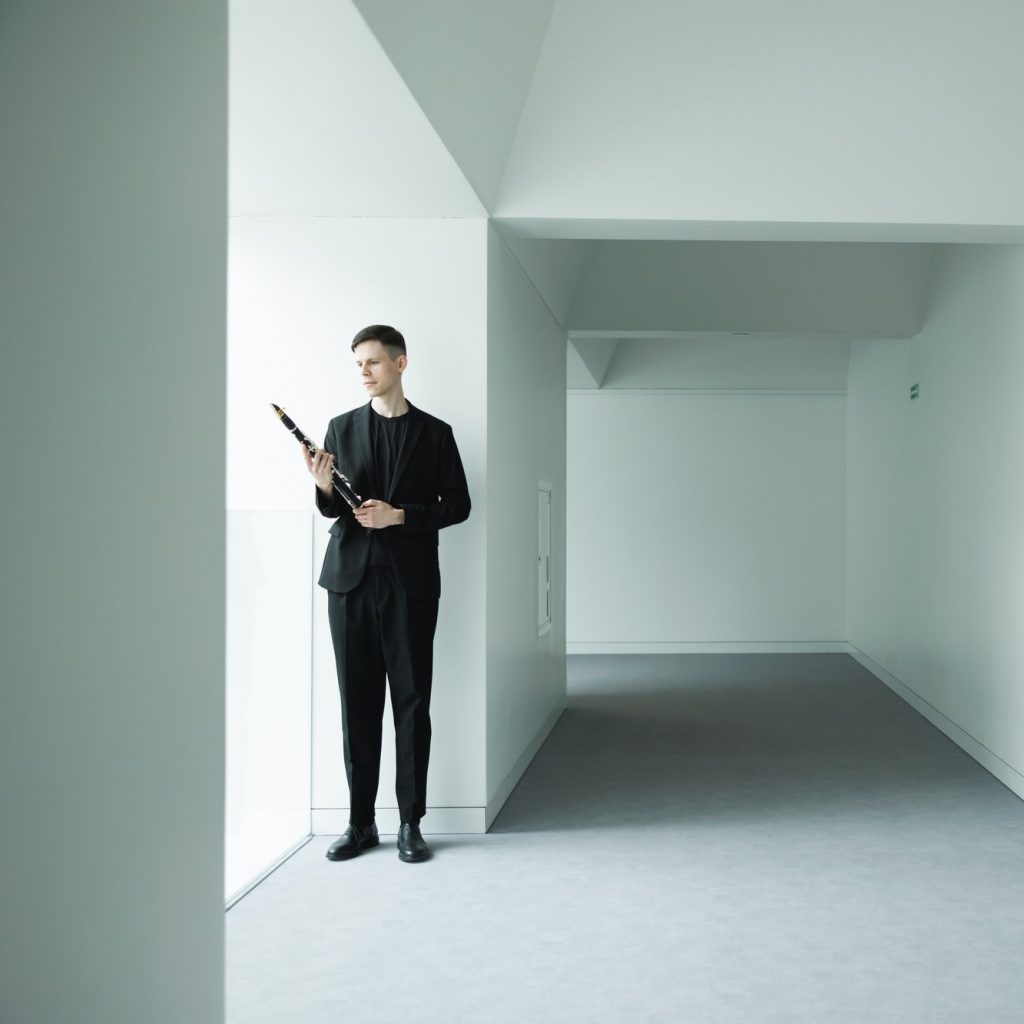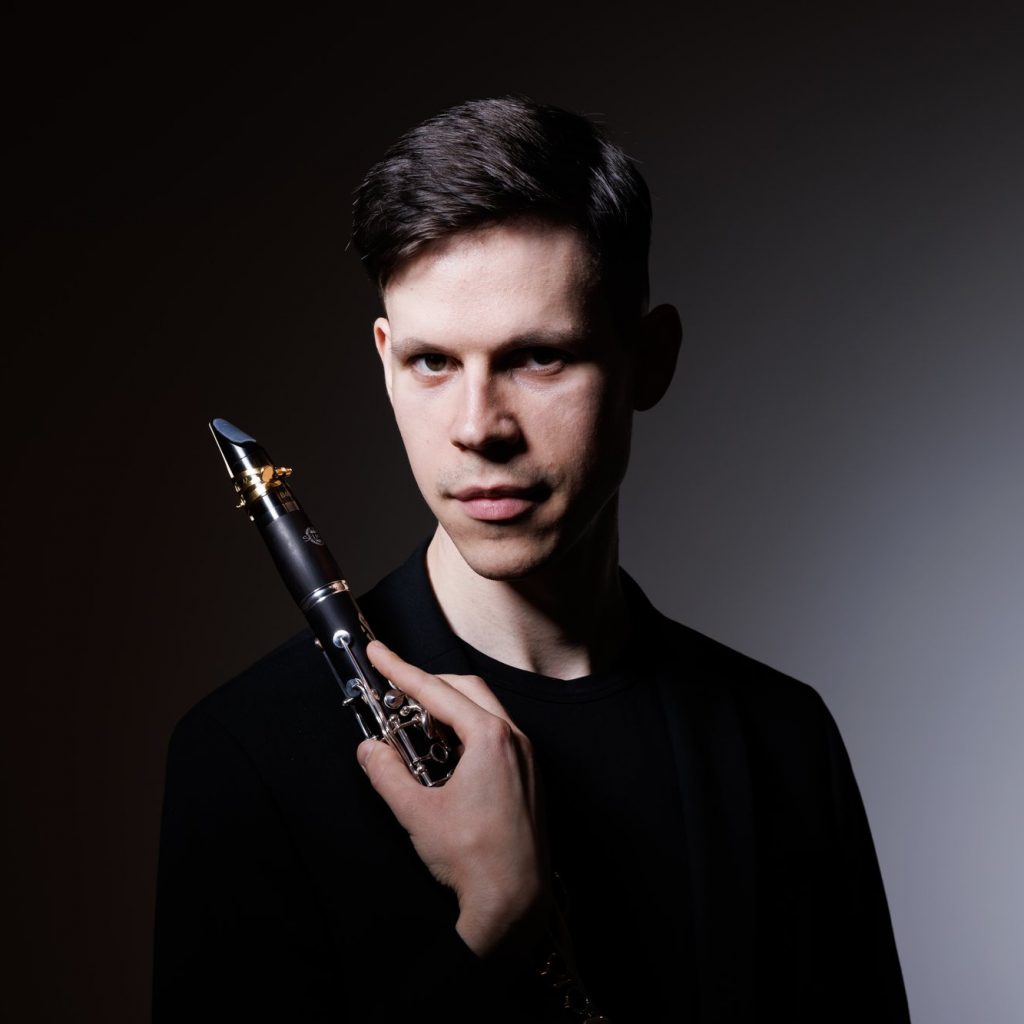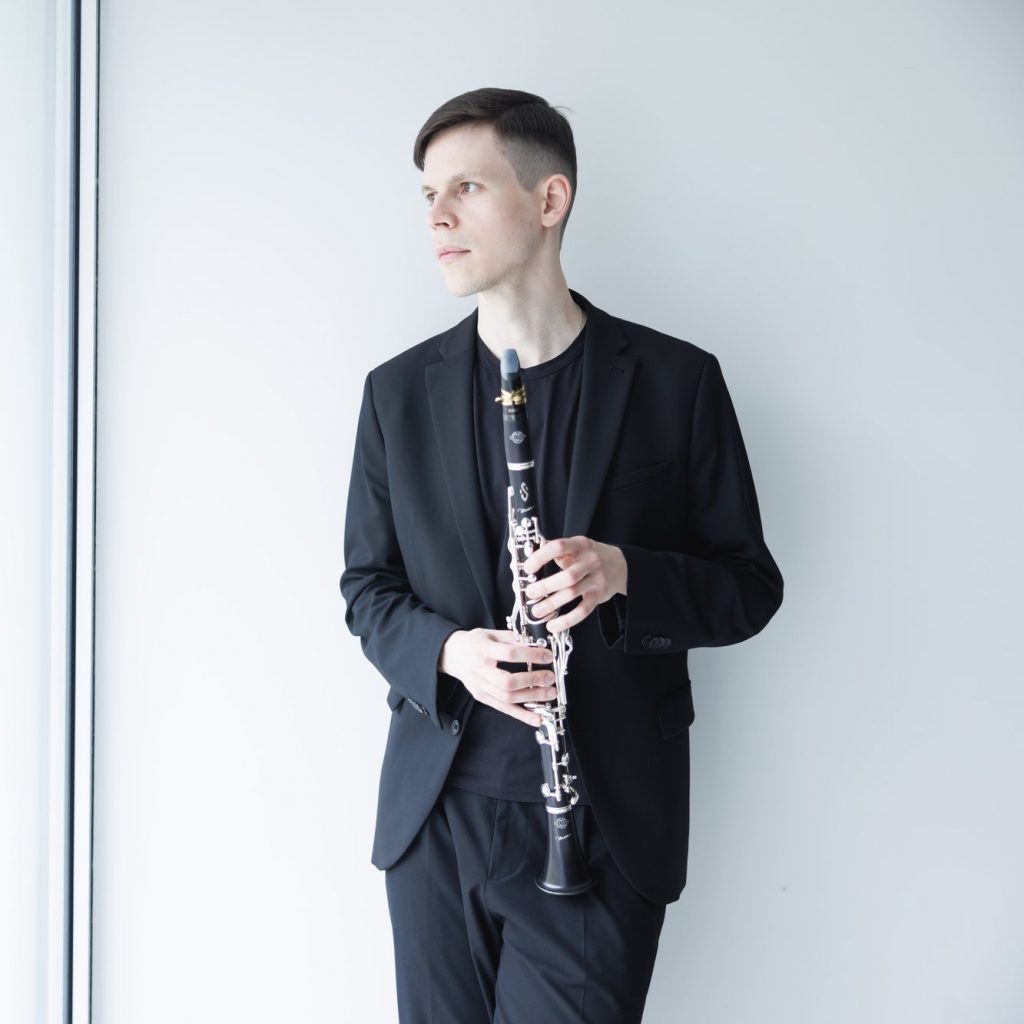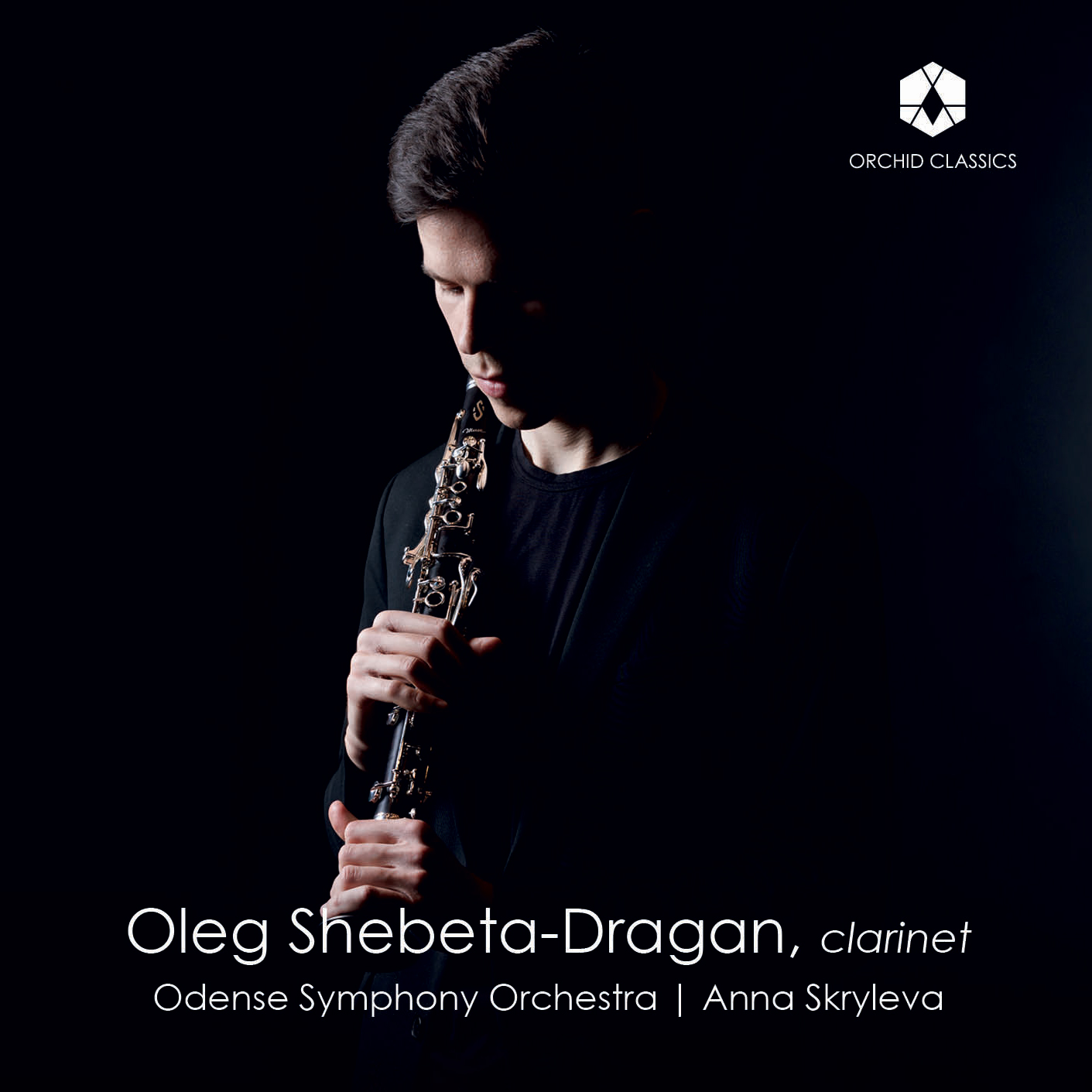For his debut recording, Oleg Shebeta-Dragan is once again joined by the Odense Symphony for works by Busoni, Milhaud and Françaix, along with Nielsen’s dynamic, intense, unpredictable and emotionally charged Clarinet Concerto.



Ferruccio Busoni (1866-1924)
1. Concertino, Op.48
Jean Françaix (1912-1997)
2. Tema con variazioni
Darius Milhaud (1892-1974)
Scaramouche, Op.165d
3. I Vif
4. II Modéré
5. III Brazileira
Carl Nielsen (1865-1931)
Clarinet Concerto, Op.57
6. I Allegretto un poco
7. II Poco adagio
8. III Allegro non troppo
9. IV Allegro vivace
Oleg Shebeta-Dragan, clarinet
Odense Symphony Orchestra
Anna Skryleva, conductor
This disc brings together the works of four very different composers whose music spans not only the nineteenth to twentieth century divide, but whose lives span Europe from Italy to Paris, Zurich to Denmark.
Darius Milhaud’s Scaramouche is probably one of his best-loved compositions – but it didn’t begin as a concert work at all. After firmly establishing his reputation in the vibrant 1920s in Paris, Milhaud spent much of the 1930s writing film and incidental music. Among his projects was a version of Molière’s comedy Le Médecin volant (The Flying Doctor) adapted for children, which was premiered in Paris in May 1937. The doctor is ‘flying’ because he is not really a doctor at all, but a character in disguise, and as the plot progresses, he has to quick-change on stage between two different identities between standing on the roof of a house and being back on the ground floor. Theatre magic – and a rope and hoop – would ‘fly’ the doctor between one and the other as he struggled to keep up the double roles.
As part of the score for this production, Milhaud composed several bouncing musical interludes which he subsequently arranged for two pianos and named Scaramouche after a commedia dell’arte character. The first movement is brilliantly lively, an almost cartoonish depiction of frantic movement: we can imagine characters scampering around the stage, and the score is full of clever changes of gear and bold juxtapositions. The second is gentler and more tender, all singing lines and imitation; while the closing ‘Brazileira’ conjures a lively dance and cheerful party atmosphere. Between 1939 and 1941 Milhaud made further arrangements for clarinet and orchestra – which we hear on this recording – and saxophone and orchestra, for Benny Goodman.
Ferruccio Busoni was born almost thirty years before Milhaud, and we tend to associate him now primarily with his virtuoso arrangements and editions of the work of J.S. Bach. But although the piano was most certainly Busoni’s principal instrument, his father Ferdinando was a virtuoso clarinettist: indeed, Busoni’s parents met when Anna Weiss, his mother, was asked to accompany Ferdinando in a performance in Trieste in 1865. Although Ferdinando spent much of Ferruccio’s early years away on tour, he later oversaw his son’s first public performances in Vienna, and also introduced him to the music of Bach. So, Busoni’s decision to compose a Concertino for clarinet and chamber orchestra in 1918 would undoubtedly have been coloured by memories of his father, who had died in 1909.
The Concertino was written in the spring of 1918 while Busoni was living in Zurich and working on his vast opera Doktor Faustus. It was dedicated to Edmonda Allegra, the principal clarinettist of the Tonhalle Orchestra, who gave the premiere in May 1918. The piece plays without a break and hops between contrasting sections: a light-hearted neoclassical Allegro sets the scene, with hints of Richard Strauss and Stravinsky, whilst the whole is rounded off with a cheery minuet. In between comes the haunting and rather unsettling Andantino, for which Busoni used a discarded setting of the song ‘Es war ein König in Thule’ from his Faustus project. The menacing atmosphere is dispelled by a recitative-like solo passage – still clearly operatic – before a singing oboe and rippling arpeggios from our soloist bring us back into the sunshine.
The composer-pianist Jean Françaix was also the son of musical parents: his mother was a singer and pedagogue, and his father was director of the conservatoire in Le Mans in north-west France. After later studies at the Paris Conservatoire and lessons from Nadia Boulanger, Françaix became a highly regarded pianist and a prolific composer, with over 200 works to his name. His Tema con Variazioni for clarinet and piano date from 1974, and the piece was subsequently transcribed by the composer for clarinet and string orchestra four years later. It is a wonderfully wistful, lyrical work: a slow introduction leads to a bouncy, major-key theme which is then put through its paces across six variations, from jazz-inflected dances to melancholy chansons that conjure echoes of Poulenc. (Françaix was friendly with the members of Les Six – including both Poulenc and Milhaud – but was never interested in adhering to a single musical ‘school’ and so never became part of the group.) The final variation is preceded with a flashy cadenza, and that spirit of high excitement and virtuosity is retained to the end of the piece, in driving piano rhythms and a flurry of clarinet figuration.
Carl Nielsen was in his early sixties when he wrote his Clarinet Concerto – part of a long-standing project to compose wind concertos for each of the five members of the Copenhagen Wind Quintet, whose playing he had been so struck by in the early 1920s that he had composed a Quintet for them in 1922. The Clarinet Concerto was the second of these promised concertos to be completed, after a Flute Concerto, but it was also the last: Nielsen died in 1931, before he could honour his promise of pieces for bassoon, horn or oboe.
This Concerto is, like Busoni’s Concertino, continuous across movements. The opening Allegretto has a bounce in its step, but there are frequent harmonic run-ins between orchestral sections and soloist, and they grate and crunch against each other with occasional militaristic outbursts from the snare drum as if trying to call the whole to order. The music runs out of steam and we move into the horn-led, lyrical Poco Adagio second movement; but this is derailed by a scampering, bitonal faster passage at its midpoint and the insistent return of the snare drum. The following Allegro is more conversational, strings and soloist in agreement or passing themes between each other (there are canons and imitations throughout this piece). The soloist is granted extended virtuosic passages and a lengthy cadenza in this movement, and we proceed at last into the finale – a frantic dance that seems to build momentum only to lose it fatally again and collapse into a mournful, lyrical central passage. There is another brief attempt to reclaim the dance; but the whole ultimately ends in quiet, floating repose.
The work was premiered by Aage Oxenvad, its dedicatee, in the autumn of 1928. Emil Telmányi, the conductor of the first performance, apparently complained that Nielsen had systematically used notes that were the hardest for the soloist to play! Although it received only a tepid response from critics at the time, it has since become one of the staples of the clarinet repertoire.
© Katy Hamilton
Here presenting his debut album, Oleg Shebeta-Dragan came to international attention in the spring of 2022 as winner of the clarinet category at the Carl Nielsen International Competition in Odense, where he also claimed the Special Prize of the Odense Symphony Orchestra and the Junior Jury Prize.
For his debut recording, Oleg Shebeta-Dragan is once again joined by the Odense Symphony for works by Busoni, Milhaud and Françaix, along with Nielsen’s dynamic, intense, unpredictable and emotionally charged Clarinet Concerto.
Oleg Shebeta-Dragan
Clarinet
Oleg Shebeta-Dragan, a Ukrainian clarinettist, shot to international attention in the spring of 2022 as the winner of the clarinet category at the Carl Nielsen International Competition in Odense. His playing was noted for its flair, brilliance, and technical finesse at the competition, where he also claimed the Special Prize of the Odense Symphony Orchestra and the Junior Jury Prize.
As a soloist, Oleg has appeared with prominent orchestras such as the Copenhagen Philharmonic Orchestra, Odense Symphony Orchestra, Lübeck Philharmonic Orchestra, Slovak Sinfonietta, Elbland Philharmonic Orchestra and Norddeutsche Sinfonietta. He is also an active chamber musician, regularly performing in various ensembles across Europe. Oleg’s debut CD was recorded with the Odense Symphony Orchestra for Orchid Classics. A Grand Prize winner of the Silverstein Global Clarinet Competition, he signed with Nordic Artists Management in 2022. Oleg is also an artist of Henri Selmer Paris. He studied with Andriy Mitrokhov and Roman Vovk, and furthered his education with Reiner Wehle and Jens Thoben at the University of Music Lübeck.
Anna Skryleva
Conductor
Anna Skryleva, the award winning conductor, composer, pianist and synaesthete, has made a name for herself on the international stage in recent years. Anna Skryleva is currently the General Music Director at Magdeburg Opera Theatre and is enthusiastically committed to expanding the current orchestral and operatic repertoire. She won the prestigious Opus Klassik award 2024 for World Premiere Recording of the Year and were nominated for Opus Klassik award 2024 as the Best Opera Recording of the Year. Skryleva received the special “Innovative Orchestra 2019” award from the German Orchestra Foundation for her tireless efforts.
As a conductor, her training has taken her through the classic stages of a general music director: from solo pianist to positions as a repetiteur, assistant and conductor, with mentors including Simone Young and Julia Jones, as well as the Institute for Women Conductors at the Dallas Opera.
Anna Skryleva regularly works as a guest at renowned opera houses and with outstanding orchestras, including the Royal Swedish Opera, the Dallas Opera, the Gewandhausorchester Leipzig, the Frankfurt Radio Symphony orchestra, the Copenhagen Philharmonic and the Deutsches Symphonie-Orchester Berlin.
Anna Skryleva has worked steadily as a composer; her works are published by Universal Edition Vienna.
Odense Symphony Orchestra
The Odense Symphony Orchestra is one of Denmark’s five regional orchestras. The orchestra was founded in 1946, but its roots go as far back as around 1800. From being a theatre orchestra that also played symphonic music, the orchestra today appears as a modern symphony orchestra with a high level of activity and in a constant state of development. The orchestra’s repertoire has a wide range and covers everything from film concerts, chamber music, family concerts to the great symphonic works and opera, such as Richard Wagner’s Der Ring des Nibelungen.
Odense Symphony Orchestra had 22 musicians at its founding but has grown to 73 permanent musicians over the years, from Denmark and all over the world. The orchestra performs around 100 concerts a year. The majority of the concerts take place in the Carl Nielsen-hall in Odense’s Concert house, near H.C. Andersen’s Birthplace – but the orchestra tours throughout Denmark and the rest of the world.
Odense Symphony Orchestra is the owner and host of Carl Nielsen International Competition, and the orchestra and its musicians play an important role in the competition as jury members, repertoire consultants and contact persons to many international artists.
The first of the Carl Nielsen International Competitions was held in Odense in 1980. After nearly four decades, the violin, clarinet and flute competitions have established themselves as some of the most demanding and rewarding in the world, by highlighting Carl Nielsen’s musical masterpieces, and offering each winner the chance to launch a significant international career.
For more information on Carl Nielsen International Competition please visit www.carlnielseninternationalcompetition.com. You can also find us on Facebook.

Click the button above to download all album assets.

